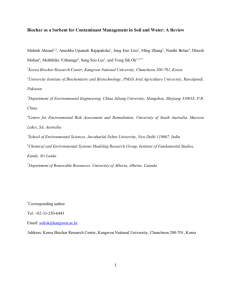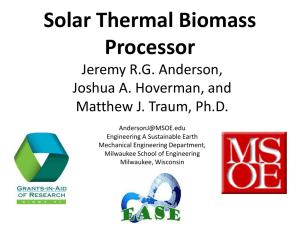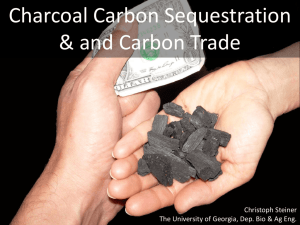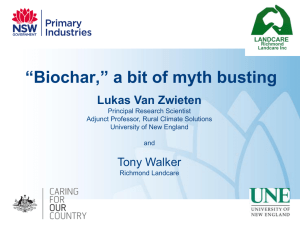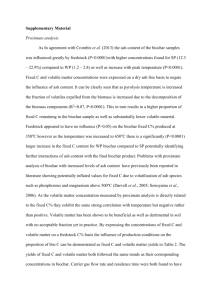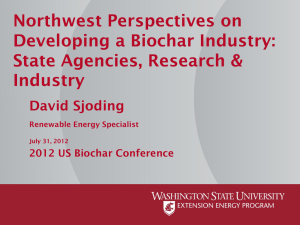Life Cycle Assessment of Biochar - The College of Natural Sciences
advertisement
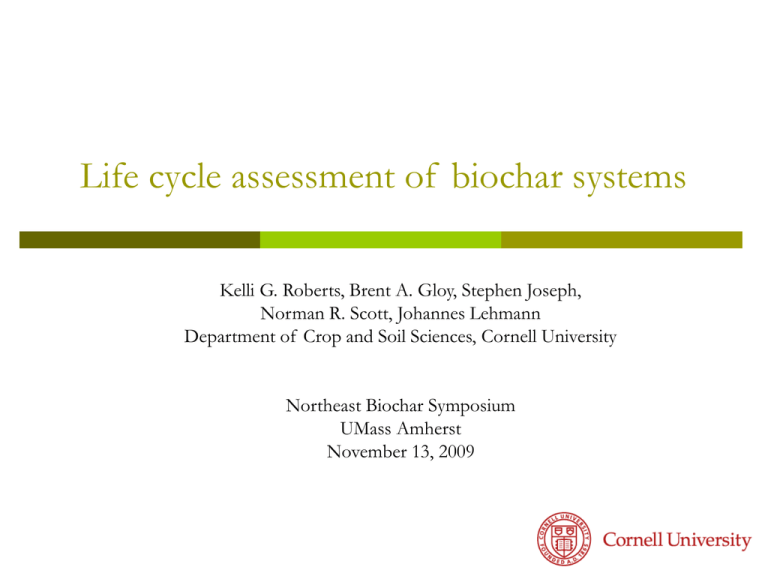
Life cycle assessment of biochar systems Kelli G. Roberts, Brent A. Gloy, Stephen Joseph, Norman R. Scott, Johannes Lehmann Department of Crop and Soil Sciences, Cornell University Northeast Biochar Symposium UMass Amherst November 13, 2009 What is Life Cycle Assessment (LCA)? Methodology to evaluate the environmental burdens associated with a product, process or activity throughout its full life by quantifying energy, resources, and emissions and assessing their impact on the global environment. LCA has been standardized by the ISO (International Organization for Standardization). materials manufacture use Life cycle of a product end of life Goals of the LCA To conduct a cradle-to-grave analysis of the energy, greenhouse gas, and economic inputs and outputs of biochar production at a large-scale facility in the US. To compare feedstocks (corn stover, yard waste, switchgrass). Scope: the functional unit The functional unit: A measure of the performance or requirement for a product system. Provides a reference so that alternatives can be compared. Our functional unit: The management of one tonne of dry biomass. System boundaries Fossil fuels production Pyrolysis facility Electricity production Heat exhaust Biochar T Biomass collection Shredding Drying Slow pyrolysis Syngas heat product T T Farm equipment, agrochemicals Compost (-) T Construction materials Dashed arrows with (-) indicate avoided processes. The “T” represents transportation. (-) Natural gas production & combustion T Soil application T (-) Fertilizers Biochar with heat co-product Installation at Frye Poultry Farm, West Virginia capacity of 300 kg dry litter hr-1 www.coaltecenergy.com LCA of biochar – industrial scale Plant throughput 10 t dry biomass hr-1 Runs at 80% capacity The slow pyrolysis process has four coproducts: Biomass waste management Biochar soil amendment Bioenergy heat production Carbon sequestration Energy flows: feedstock to products Sankey diagram, per dry tonne stover Feedstocks Corn stover Yard waste Late and early harvest (15% and 30% mcwb). Second pass collection, harvest 50% above ground biomass. 45% mcwb No environmental burden for production. Assumed to be diverted from large-scale composting facility. Switchgrass 12% mcwb Scenarios A and B to capture range of GHG flows associated with land-use change Feedstocks (cont.) Switchgrass A Lifecycle emissions model (Deluchi), informally models landuse change. Assumes land conversion predominantly temperate grasses and existing croplands, rather than temperate, tropical or boreal forests. Net GHG of +406.8 kg CO2e t-1 dry switchgrass harvested. Switchgrass B Searchinger et al (2008) global agricultural model. Assumes land conversion in other countries from forest and pasture to cropland to replace the crops lost to bioenergy crops in the U.S. Net GHG of +886.0 kg CO2e t-1 dry switchgrass harvested. Deluchi, M. “A lifecycle emissions model (LEM)”; UCD-ITS-RR-03-17; UC Davis, CA, 2003. Searchinger, T.; et al. Science 2008, 319 (5867), 1238-1240. Pyrolysis and biochar parameters Feedstock properties, pyrolysis process yields, and biochar properties for various biomass sources Late stover Early stover Switch grass Yard waste 15% 30% 12% 45% Ash content (wt.% DM) 5.6 5.6 4.6 4.5 C content of feedstock (wt.% DM) 45 45 48 47 16000 16000 17000 18000 Property Moisture content, wet basis Lower heating value (MJ t-1 DM) Feedstock to heat energy efficiency 37% Yield of biochar (wt. %) 29.60 29.60 28.80 29.63 C content of biochar (wt.%) 67.68 67.68 63.09 65.89 Stable portion of total C in biochar 80% Improved fertilizer use efficiency (for N, P, K) 7.2% Reduced soil N2O emissions from applied N fertilizer 50% Energy balance Energy (MJ t -1 dry feedstock) Late stover cons. Early stover cons. Switch grass 0 cons. 2000 4000 Net = + 4116 gen. 6000 agrochems field ops Net = + 3044 drying chipping gen. biomass trans Net = + 4899 plant constr other gen. Yard waste syngas heat cons. gen. Net = + 4043 avoid fos fuel avoid compost All feedstocks are net energy positive. Switchgrass has the highest net energy. Agrochemical production and drying consume largest proportion of energy. Biomass and biochar transport (15 km) consume < 3%. “Other” category includes biochar transport, plant dismantling, avoided fertilizer production, farm equipment, and biochar application. GHG emissions balance -1 Greenhouse gases (kg CO 2e t dry feedstock) Yard Switch Switch waste grass B grass A Early stover Late stover 0 emit. 300 600 900 Net = - 864 LUC & field emiss. agrochems Net = - 793 field ops reduct. emit. reduct. emit. other Net = - 442 reduct. emit. Net = + 36 reduct. emit. Net = - 885 stable C avoid foss fuel gen. & comb. land-use seq. reduced soil N2O emiss. avoid compost reduct. Stover and yard waste have net (-) emissions (greater than -800 kg CO2e). However, switchgrass A has -442 kg CO2e of emissions reductions, while B actually has net emissions of +36 kg CO2e. “Other” category includes biomass transport, biochar transport, chipping, plant construction and dismantling, farm equipment, biochar application and avoided fertilizer production. -1 Early stover Late stover 0 Yard Switch Switch waste grass B grass A GHG emissions (cont.) Greenhouse gases (kg CO 2e t dry feedstock) emit. 300 600 900 Net = - 864 LUC & field emiss. agrochems Net = - 793 field ops reduct. emit. reduct. emit. other Net = - 442 reduct. emit. Net = + 36 reduct. emit. Net = - 885 stable C avoid foss fuel gen. & comb. land-use seq. reduced soil N2O emiss. avoid compost reduct. Biomass and biochar transport (15 km) each contribute < 3%. The stable C sequestered in the biochar contributes the largest percentage (~ 56-66%) of emission reductions. Avoided natural gas also accounts for a significant portion of reductions (~26-40%). Reduced soil N2O emissions upon biochar application to the soil contributes only 2-4% of the total emission reductions. High revenue scenario $80 t-1 CO2e Low revenue scenario $20 t-1 CO2e Late stover Switch grass A +$8 -$18 Switch grass B -$17 -$28 -$30 Yard waste Economic analysis +$35 -120 +$69 +$16 -80 -40 biomass collection pyrolysis biochar application tipping fee biochar P & K content carbon value 0 40 80 cost ($ t-1 dry feedstock) 120 160 biomass transport biochar transport lost compost revenue avoided compost cost biochar improved fertilizer use syngas heat The high revenue of late stover (+$35 t-1 stover). Late stover breakeven price is $40 t-1 CO2e. Switchgrass A is marginally profitable. Yard waste biochar is most economically viable. Highest revenues for waste stream feedstocks with a cost associated with current management. 200 Stable C vs. life cycle emissions Net profits valuing stable C only ($ t-1 DM) ($ t-1 DM) Late stover Switchgrass A & B Yard waste High revenue scenario $13 $17 $44 Low revenue scenario -$23 $8 $10 Yard waste still most profitable Stover and switchgrass have switched Net revenue -200 6000 60 5000 30 4000 -400 Net energy 3000 -600 2000 Net GHG -800 Net energy (MJ t-1 dry stover) Net GHG (kg CO2e t-1 dry stover) 0 0 -30 -60 Revenue ($ t-1 dry stover) Transportation sensitivity analysis 1000 -90 -1000 0 0 200 400 600 800 1000 Distance (km) The net revenue is most sensitive to the transport distance, where costs increase by $0.80 t-1 for every 10 km. The net GHG emissions are less sensitive to distance than the net energy. Transporting the feedstock and biochar each 200 km, the net CO2 emission reductions decrease by only 5% of the baseline (15 km). Biochar systems are most economically viable as distributed systems with low transportation requirements. Biochar-to-soil vs. biochar-as-fuel Net GHG Biochar-as-fuel: biochar production with biochar combustion in replacement of coal are -617 kg CO2e t-1 stover Biochar-to-soil: -864 kg CO2e t-1 stover 29% more GHG offsets with biochar-to-soil rather than biochar-as-fuel Biomass direct combustion vs. biochar-to-soil Net GHG Not including avoided fossil fuels: Biomass direct combustion: +74 kg CO2e t-1 stover Biochar-to-soil: -542 kg CO2e t-1 stover Emission reductions are greater for a biochar system than for direct combustion With avoided natural gas: Biomass direct combustion: -987 kg CO2e t-1 stover Biochar-to-soil: -864 kg CO2e t-1 stover Net GHG look comparable However, for biochar-to-soil, 589 kg of CO2 are actually removed from the atmosphere and sequestered in soil, whereas the biomass combustion benefits from the avoidance of future fossil fuel emissions only Transparent system boundaries Conclusions Careful feedstock selection is required to avoid unintended consequences such as net GHG emissions or consuming more energy than is generated. Waste biomass streams have the most potential to be economically viable while still being net energy positive and reducing GHG emissions (~ 800 kg CO2e per tonne feedstock). Valuing greenhouse gas offsets at a minimum of $40 t-1 CO2e and further development of pyrolysis-biochar systems will encourage sustainable strategies for renewable energy generation and climate change mitigation. Next steps Preliminary results: Mobile unit for stover biochar Without energy capture Net GHG = -550 kg CO2e t-1 stover Net energy = -1000 MJ t-1 stover Different biochar-pyrolysis sytems Mobile unit Small-scale non-mobile, batch units With and without energy capture www.biocharengineering.com Brazilian type metal kiln, Nicolas Foidl Next steps Developing country scenarios Household cook stoves Village scale units Central plant at biomass source Pro-Natura in Senegal Different feedstocks Manures Native grasses on marginal lands Cook stoves in Kenya Acknowledgements Cornell Center for a Sustainable Future (CCSF) John Gaunt (Carbon Consulting) Jim Fournier (Biochar Engineering) Mike McGolden (Coaltec Energy) Lehmann Biochar Research Group, especially Kelly Hanley, Thea Whitman, Dorisel Torres, David Guerena, Akio Enders Thank you! Feedstock properties, pyrolysis process yields, and biochar properties for various biomass sources Late stover Early stover Switchgra ss Yard waste 15% 30% 12% 45% Ash content (wt.% DM) 5.6 5.6 4.6 4.5 C content of feedstock (wt.% DM) 45 45 48 47 Lower heating value (MJ t-1 DM) 16000 16000 17000 18000 Yield of biochar (wt. %) 29.60 29.60 28.80 29.63 C content of biochar (wt.%) 67.68 67.68 63.09 65.89 Property Moisture content, wet basis Stable portion of total C in biochar 80% Improved fertilizer use efficiency (for N, P, K) 7.2% Reduced soil N2O emissions from applied N fertilizer 50% DM = dry matter Pyrolysis facility costs Costs (2007 USD) Pretreatment Operating ($ t-1 DM) $4.77 Capital ($ t-1 DM) $4.12 $3.6 M Total Pyrolysis Operating ($ t-1 DM) $26.81 Capital ($ t-1 DM) $12.14 Iron Total Operating ($ t-1 DM) $31.58 Total Capital ($ t-1 DM) $16.26 Total ($ t-1 DM) $47.84 $10.6 M Total Costs and revenues per dry tonne of feedstock. Each feedstock has a low and high revenue scenario, representing $20 and $80 per tonne CO2e sequestered, respectively Late stover Low high Switchgrass A Low High Switchgrass B low High Yard waste low high Biochar P & K content 18.39 9.68 9.68 10.01 Improved fertilizer use 1.22 1.18 1.18 1.22 C value 17.28 Energy 69.12 8.84 35.36 -0.72 -2.88 17.70 70.80 42.81 55.05 55.05 35.20 Tipping fee NA NA NA 49.09 Avoided compost cost NA NA NA 10.98 Lost compost revenue NA NA NA -56.03 -43.46 -36.89 -36.89 NA Biomass -6.24 -6.02 -6.02 NA Biochar -1.57 -1.53 -1.53 -1.57 Biochar application -1.07 -1.04 -1.04 -1.07 Operating -31.58 -31.58 -31.58 -31.58 Capital -16.26 -16.26 -16.26 -16.26 Feedstock Transport Pyrolysis Net value ($) -17.07 34.77 -18.57 7.95 -30.29 -28.13 15.87 68.97
